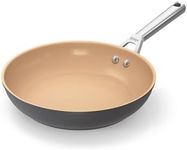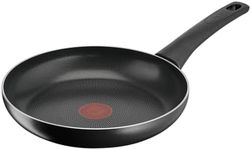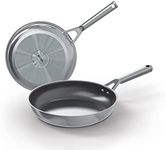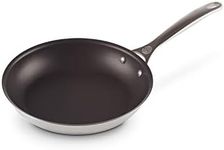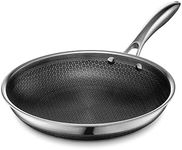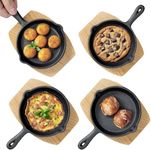Buying Guide for the Best Nonstick Frying Pans
Choosing the right nonstick frying pan can significantly enhance your cooking experience. Nonstick pans are popular for their ease of use and cleaning, making them a staple in many kitchens. When selecting a nonstick frying pan, consider the type of cooking you do most often, the level of maintenance you're willing to commit to, and the longevity you expect from your cookware. Understanding the key specifications will help you make an informed decision that suits your cooking style and needs.MaterialThe material of a nonstick frying pan affects its heat conductivity, weight, and durability. Common materials include aluminum, stainless steel, and hard-anodized aluminum. Aluminum pans are lightweight and heat up quickly, making them ideal for everyday cooking. Stainless steel pans are more durable and often have a core of aluminum or copper for better heat distribution. Hard-anodized aluminum is a more durable version of regular aluminum, offering better resistance to scratches and dents. Choose a material based on your cooking habits: if you need quick heating, go for aluminum; if you want durability, consider stainless steel or hard-anodized options.
Coating TypeThe type of nonstick coating determines how easily food releases from the pan and how long the pan will last. Common coatings include PTFE (like Teflon) and ceramic. PTFE coatings are known for their excellent nonstick properties and are great for low-fat cooking. Ceramic coatings are free from synthetic chemicals and are often marketed as a healthier option, though they may not last as long as PTFE. If you prioritize easy food release and low maintenance, PTFE might be the way to go. If you prefer a more eco-friendly option, consider ceramic.
SizeThe size of the frying pan affects how much food you can cook at once. Common sizes range from 8 to 12 inches in diameter. An 8-inch pan is suitable for single servings or small tasks like frying an egg. A 10-inch pan is versatile for most home cooking needs, accommodating meals for two to three people. A 12-inch pan is ideal for larger families or when cooking bigger portions. Consider the size of your household and the types of meals you typically prepare when choosing the size of your pan.
Handle TypeThe handle of a frying pan affects comfort and safety during use. Handles can be made from stainless steel, silicone, or plastic. Stainless steel handles are durable and oven-safe, but they can get hot. Silicone handles offer a comfortable grip and stay cool, but they may not be oven-safe at high temperatures. Plastic handles are often the most affordable but can limit the pan's oven use. Choose a handle type based on how you plan to use the pan: if you frequently transfer from stovetop to oven, a stainless steel handle might be best; for stovetop use only, silicone or plastic could be more comfortable.
Oven CompatibilityOven compatibility refers to whether a frying pan can be used in the oven and at what temperature. This feature is important if you plan to finish dishes in the oven or use the pan for baking. Check the manufacturer's guidelines for the maximum oven-safe temperature. Some pans are safe up to 350°F, while others can withstand temperatures of 500°F or more. If you often cook dishes that require oven finishing, ensure your pan is compatible with the temperatures you need.
Induction CompatibilityInduction compatibility means the pan can be used on an induction cooktop, which requires a magnetic base. Not all nonstick pans are induction-compatible, so if you have an induction stove, this is a crucial feature. Look for pans specifically labeled as induction-compatible, which often have a stainless steel or magnetic base. If you use an induction cooktop, ensure the pan you choose is compatible to avoid any cooking issues.



